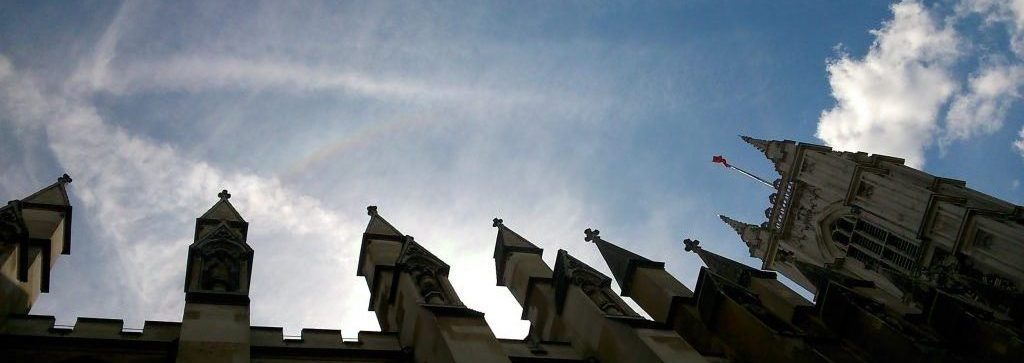The Way of Wisdom in Stratford Caldecott’s The Radiance of Being (Angelico Press, 2013)
By Fr Dominic White, o.p.
 According to the Book of Proverbs, Wisdom calls and raises her voice. But do we hear her? Perhaps her voice seems hard to hear because she speaks from a distance: from the heights, at the crossroads outside the city gates (Proverbs 8:1-3). Stratford Caldecott spoke neither from the perspective of the secular city, nor from the centre of academic theology. Yet he spoke from the heights of contemplation that arise from the deepest yearnings of the human heart, and from that crossroads which is the “orthodox centre” of Catholic Christianity, the true meeting point of the great wisdom traditions of humankind. Some of these traditions, even those found in Scripture, are little known. Like the height of heaven and the breadth of the earth with which Wisdom is concerned, Wisdom, a kindly intelligent and holy spirit (Wisdom 7) is herself hidden, as St Paul reminds us (1 Corinthians 2:7). But just who is Wisdom (or “Sophia”, in the Greek of the Bible)? Is she “just” a metaphor, an allegorical figure like the virtues that grace Victorian stained-glass windows?
According to the Book of Proverbs, Wisdom calls and raises her voice. But do we hear her? Perhaps her voice seems hard to hear because she speaks from a distance: from the heights, at the crossroads outside the city gates (Proverbs 8:1-3). Stratford Caldecott spoke neither from the perspective of the secular city, nor from the centre of academic theology. Yet he spoke from the heights of contemplation that arise from the deepest yearnings of the human heart, and from that crossroads which is the “orthodox centre” of Catholic Christianity, the true meeting point of the great wisdom traditions of humankind. Some of these traditions, even those found in Scripture, are little known. Like the height of heaven and the breadth of the earth with which Wisdom is concerned, Wisdom, a kindly intelligent and holy spirit (Wisdom 7) is herself hidden, as St Paul reminds us (1 Corinthians 2:7). But just who is Wisdom (or “Sophia”, in the Greek of the Bible)? Is she “just” a metaphor, an allegorical figure like the virtues that grace Victorian stained-glass windows?
In one of his last books, The Radiance of Being: Dimensions of Cosmic Christianity (Angelico Press, 2013), Stratford devotes an entire section to Sophia, including the question of visions of Sophia. Stratford himself, as a young man, had had visionary dreams of the Holy Grail, but, as Adrian Walker says in his preface,
He does not hector or preach, nor does he try to prove. He simply shows—deftly opening a series of windows through which the reader may behold the light of being with his own eyes […]. Instead of just persuading us to see things from the author’s point of view, it performs the nobler service of freeing us to look at things as they truly are.
Stratford’s sweep is characteristically wide and deep, just as in the Bible Wisdom explores cosmic mysteries. And, again like Wisdom, Stratford seeks to reconnect heaven and earth (re-ligion, according to scholars such as Joseph Campbell, means “binding back together”). He looks at the human desire for God, and shows how the tripartite human nature—body, soul, and spirit—reflect the Trinity, the human spirit being the part of us that is turned to the face of God. Wisdom is the reconciler, God’s way of working in us and with us towards the new heaven and new earth, in which everything will realise its full identity. He is not afraid of drawing on mystical theology to support this: St Teresa Benedicta of the Cross (Edith Stein) helps him with mystical union. Likewise, the collaboration of Hans Urs von Balthasar with the mystic Adrienne von Speyr enables him to uphold the orthodox Catholic doctrine of the eternity of hell, while also “daring to hope” that it might be empty, and with Julian of Norwich, seeing the possibility that even the worst things might, in the end, be made “well”.
Grounding his cosmology and anthropology firmly in the theology of the Trinity, Stratford is equipped to take us for a walk on the wild side. He looks at esoteric visionaries of Sophia such as Jacob Boehme, whom even Balthasar had dismissed, theologians such as Bulgakov, who had been suspected of heresy, and the hermeticist Valentin Tomberg. The biggest challenge he presents, though, is to the presuppositions of much modern academic theology:
It would not even necessarily make things clearer if we could identify in each case, historical-critical fashion, the sources and influences that have shaped the imagination of these writers and given them their vocabulary. It does not matter to me a great deal whether the Zohar (the great text of Kabbalah), so influential on most subsequent esoteric writers, originated in the third or the thirteenth century, and was the invention of Moses de Leon or a long oral tradition, any more than I worry over the identity of Denys the Areopagite or Hermes Trismegistus. I am more interested in the “ring of truth” that one may hear in these texts (p. 251).
In other words, the sensus fidelium—the sense of the faithful—at the orthodox centre. The highest theology, and the simplest Catholic praying before a statue of a favourite saint: both meeting in the same place. And, one may add, the call of wisdom is heard, faintly yet insistently, by those outside the visible bounds of the Church, who seek with a truthful and humble heart. Stratford himself had once been among their number.
So seeking the “ring of truth”, it is astonishing what Stratford can salvage and untangle from the white heat of visionaries’ language which struggles to put the ineffable into words. He finds in Boehme a portrait of God dynamic outside of time, from whom creation overflows in love, mediated by the Seven Spirits of Revelation. In Solovyov’s reflections on his visions of Sophia as a beautiful woman whom he saw in a library, in the doorway of the iconostasis of a Russian church, and, at her direction, in Egypt, Stratford finds the Russian master incorporating the best of philosophy in a deeper orthodoxy. Oscar Milosz’s sophianic visions anticipate the Big Bang; while the Catholic convert Valentin Tomberg brings together Mary and Sophia in a baptism of Hermeticism and Kabbalah.
All this is drawn together as Stratford proposes a three stage incorporation of creation’s being in Sophia, the “sharing in the divine nature” of 2 Peter 1:4 which Eastern Christianity calls thesosis. The sophianic work of incorporating creation begins with the Virgin Mary, spouse of the Holy Spirit and Mother of the Word; second in the Church, the Bride of the Lamb and as such a corporate person; and finally as the Eschatological Bride of the Father, now divine Sophia, clothing the Father in the Shekinah, the glory of God, as the Father’s home in the new heaven and new earth.
Then suddenly, Stratford takes a literary turn: he invokes as the image of the reunion of created and uncreated nature the White Rose of Dante’s Paradiso. The White Rose dwells above the Primum Mobile, in the empyrean, the unmoving sphere of divine peace, where Dante sees his Beatrice, the Blessed Virgin Mary, and glimpses the Trinity. Why this literary turn? Stratford had in fact already prepared us for it in his discussion of Boehme, pointing out that Boehme is not trying to write theology, but in the active imagination of the spirit turned up towards God, finding a place for mythological and poetic speech.
This is not just because Stratford had a keen appreciation (and huge knowledge) of literature. Nor even because he was a gentle and kind man (I remember after a conversation with him feeling delighted that I had been put right but in no way put down). The key to understanding Stratford’s literary-theological approach is his relational understanding of being. X is not just X; it is X only in relation to not-X.*
But the deepest reason for Stratford’s relational understanding of being and literary approach to theology lies in something so fundamental that it is often forgotten. His works are not the product of a solitary mind. They are the fruit of his collaboration from student days with his wife Léonie, a writer, to whom The Radiance of Being is dedicated. Their spiritual pilgrimage, their projects and their conversations are reflected in the sheer richness of Stratford’s thought. The kindly spirit of Wisdom, the revealer of cosmic mysteries and guide of well-travelled sages; the architect, harmoniser or child, according to different readings of Proverbs 8:31.
There is a final quality in Stratford’s sophiology which is hard to put into words, a quality even beyond remarkable theology written with literary imagination. It is the quality of meditation, which, as Valentin Tomberg said, is thinking in the presence of God. So if you are asking yourself “who is Sophia?”, read The Radiance of Being. You will meet her at the joining of your head and your heart.
*Interestingly the contemporary Hungarian sophiologist Fr István Cselényi insists strongly on the relational nature of being in his The Maternal Face of God? Explorations in Catholic Sophiology (Angelico Press/Sophia Perennis, 2017).
Fr Dominic White is a member of Order of Preachers, and campus minister at Newcastle University and Northumbria University in the north of England. He is the author of The Lost Knowledge of Christ: Contemporary Spiritualities, Christian Cosmology, and the Arts (Liturgical Press, 2015), a composer, and the founder of the Cosmos dance project.
The Radiance of Being is available for purchase in our shop.

